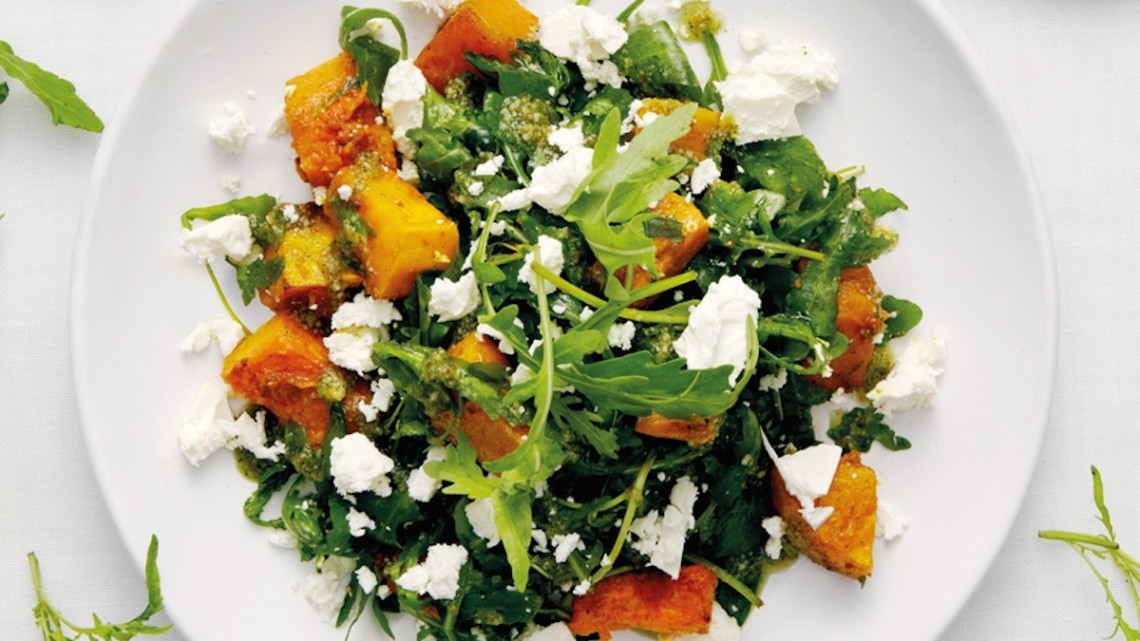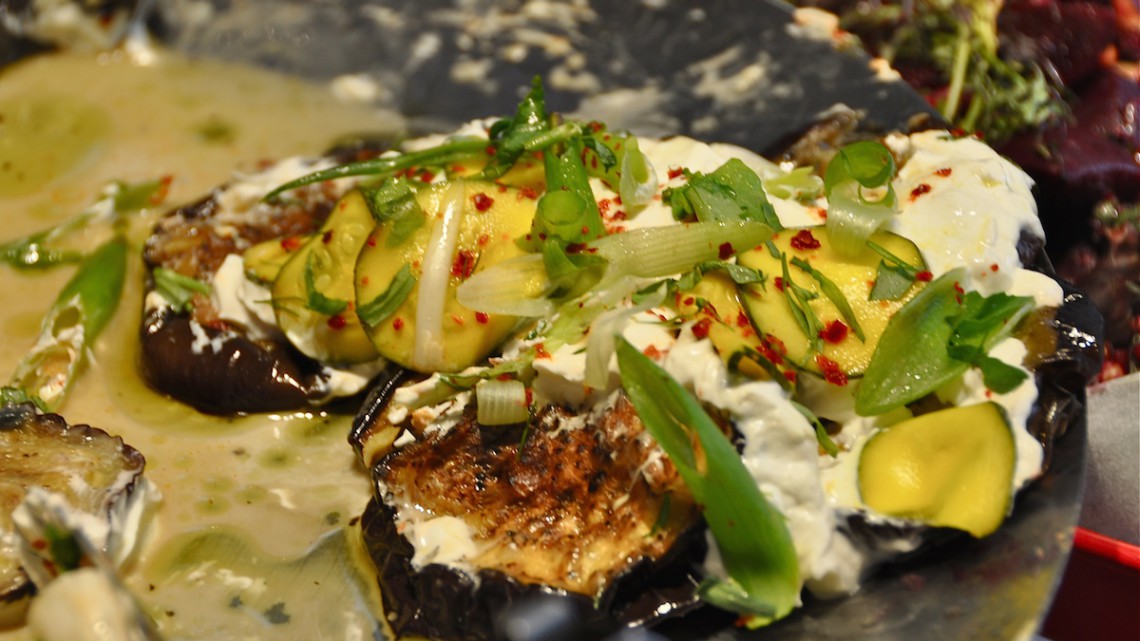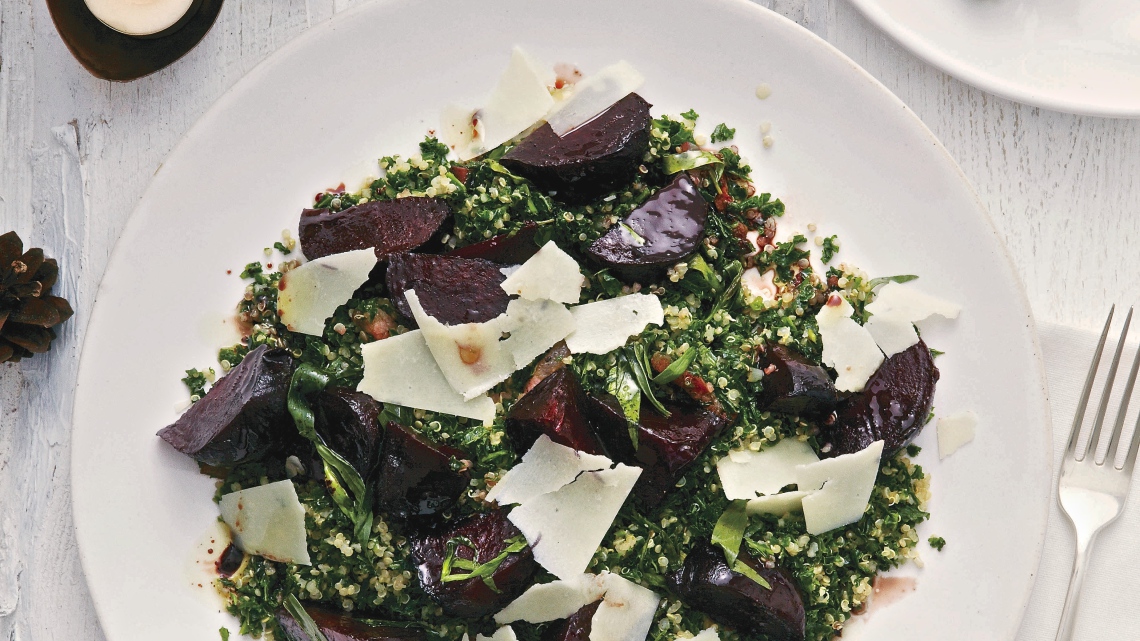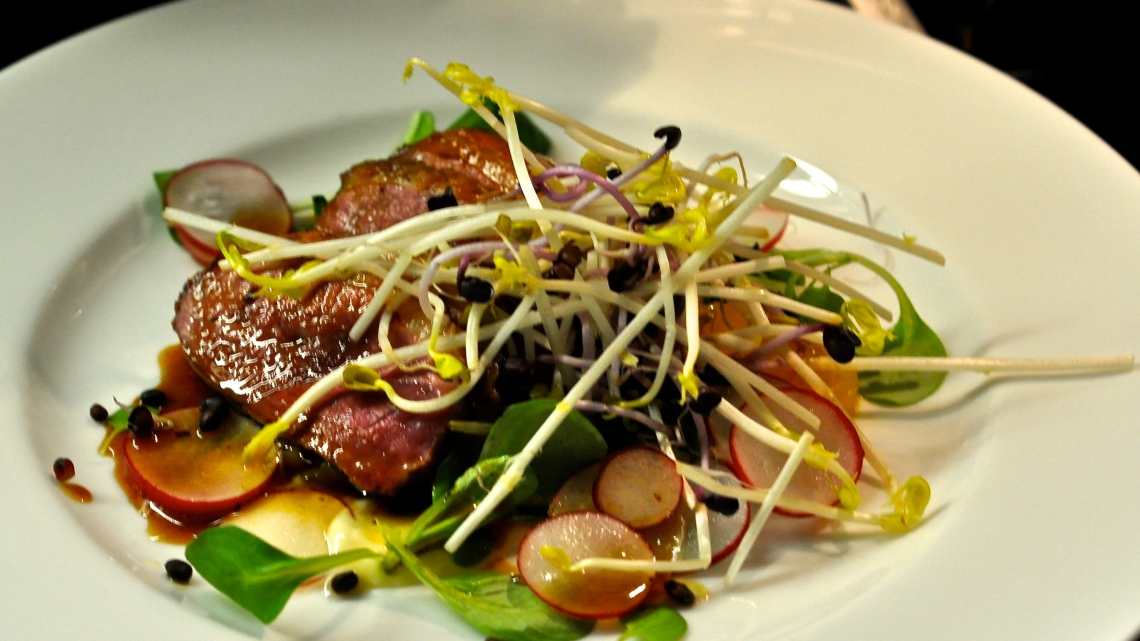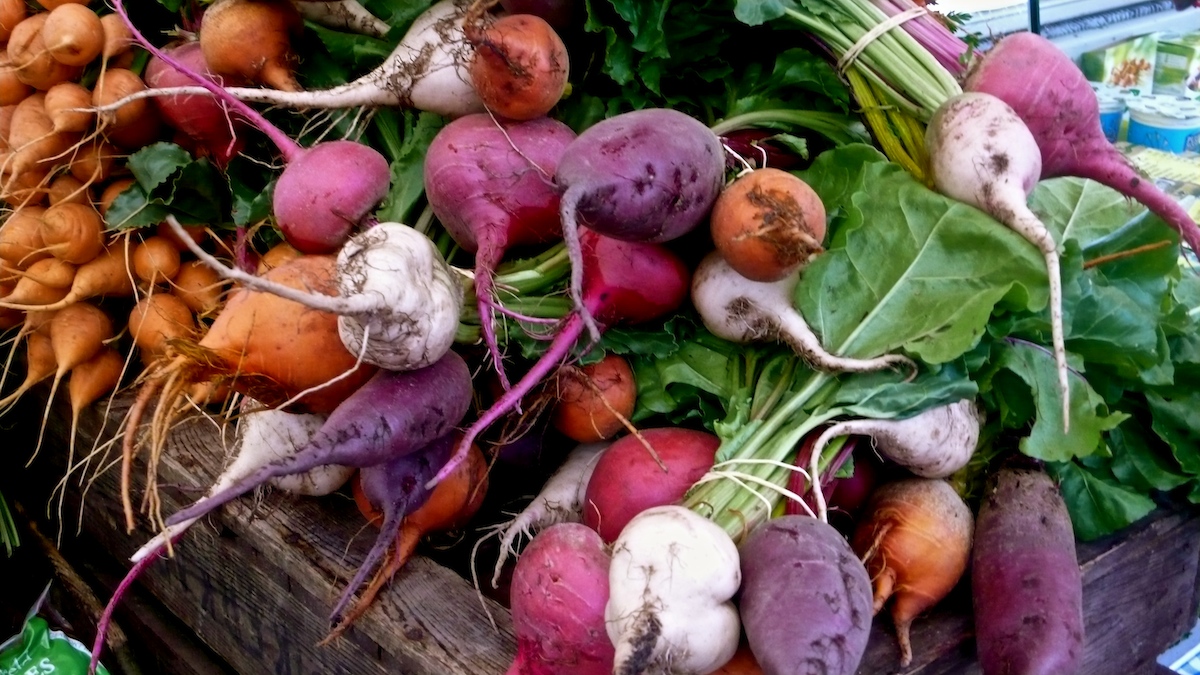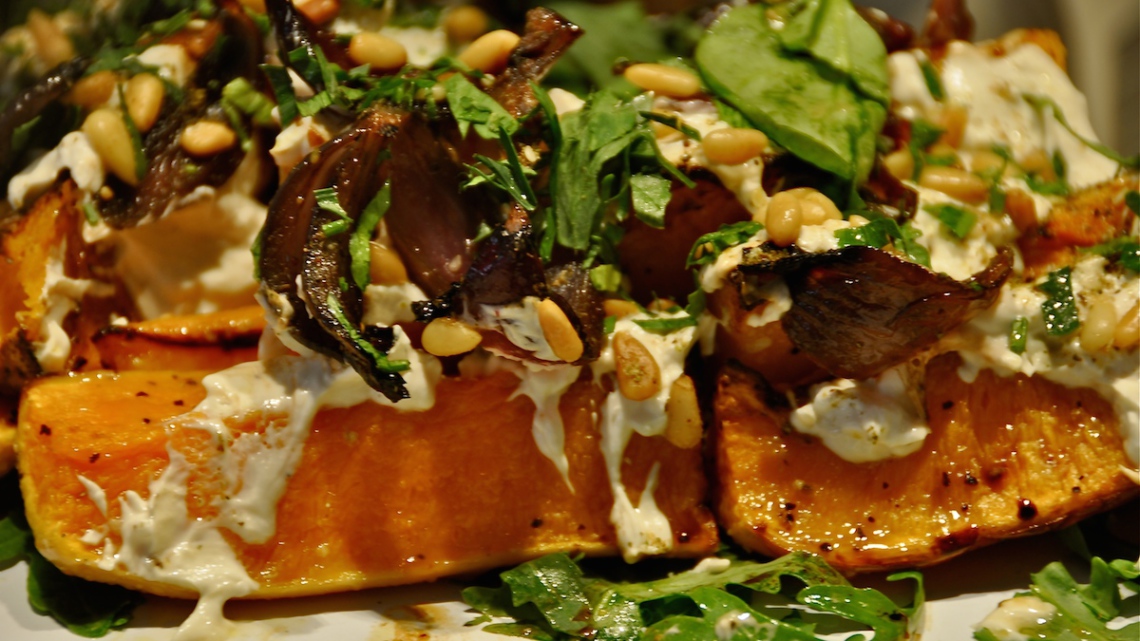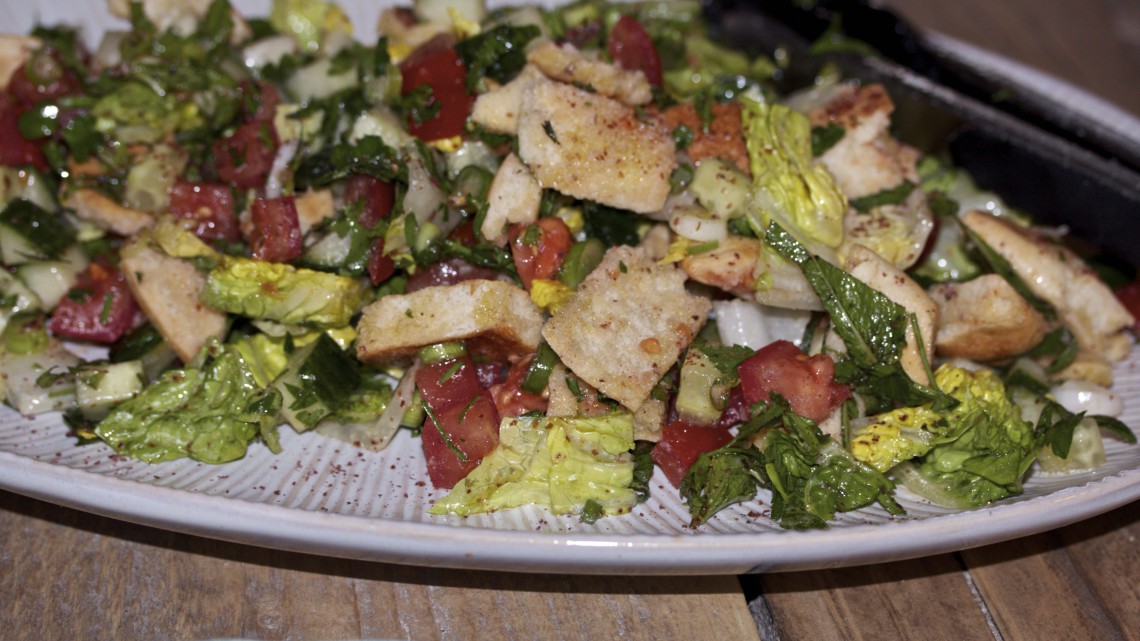Curry-Roasted Pumpkin and Feta Salad with Pesto
Serves 4
Ingredients
2 kg butternut squash
100 g feta
60 ml pesto (homemade or bought)
1 bag rocket
1 tablespoon mild curry powder
Olive oil
Salt
Pepper
Method
Preheat the oven to 210° C. Peel the pumpkin with a vegetable peeler and cut lengthways in half. Remove the seeds and chop into 3 cm cubes.
Transfer the pumpkin to a roasting dish, sprinkle with olive oil, curry powder, salt and pepper. Roast for 15-20 minutes in the oven or until the pumpkin is soft but still holding its shape. Allow to cool off slightly.
Crumble the feta and dress the rocket with olive oil, salt and pepper.
Lay the roasted pumpkin on a serving platter. Scatter over the crumbled feta and drizzle with the pesto. Top with the rocket and serve.
Also delicious as a side dish served with roast chicken.
We, the Amsterdam Flavours chefs, hope you enjoy this recipe as much as we do. If you have any questions on how to prepare it or just want to send us your feedback, you can reach us here Contact Amsterdam Flavours
Aubergine Salad with Yoghurt Dressing and Pickled Courgette
This combination takes the humble aubergine and courgette to a new level. At first glance, it may seem like a lot of ingredients but don't let that put you off. A lot of them are store cupboard staples. If you don't happen happen to have them at hand, they are easily available from your local market or supermarket. If you don't want to make the pickle, just use some flash fried thinly sliced courgette or finely shaved raw courgette dressed with some lemon juice and olive oil. This dish is delicious served as a salad or as an accompaniment to grilled lamb cutlets or fish.
Serves 4
Ingredients
3 aubergines
olive oil
salt and pepper
4 spring onions
1 red chilli
1 small bunch flat leaf parsley
1 small bunch basil
1 small bunch mint
Yoghurt dressing
200 g Greek yoghurt
1 lemon
2 tablespoons olive oil
1 tablespoon water (or a little more if required)
salt and pepper
Pickled Courgette
1 large courgette
1 tablespoon salt
70 g demarara sugar
1/2 teaspoon dried chilli flakes
1/2 teaspoon turmeric powder
2 small shallots
250 ml cider vinegar
1/2 teaspoon mustard seeds
1/4 teaspoon fennel seeds
Method
Begin with the courgette pickle. Slice the courgette and shallots as thinly as possible. If you have a mandolin, you can slice the courgette on that, but mind your fingers. Place the courgette and shallot in a bowl with the salt and leave to stand for 15 minutes. Toast the mustard and fennel seeds in a dry pan to release their aromas. Transfer to a bowl and add the remaining ingredients, stirring until the sugar dissolves. Pour off any liquid from the courgette and shallots and place them in the pickling liquid. At least an hour in the pickle would be great before serving. These don't really keep for long and are best eaten on the day they are made.
Now on to the dressing; place the Greek yoghurt in a bowl and grate the zest of the lemon over. Add 3 tablespoons lemon juice (or to taste), 2 tablespoons olive oil, salt, pepper and 1 tablespoon water. Whisk to a smooth dressing. It should have the consistency of thick pouring cream. If it's a little on the thick side, add a little extra water. Set aside.
Slice the aubergine lengthways into 1 cm thick slices. Heat a griddle pan over medium-high heat. Brush the aubergine slices with olive oil and season with salt and pepper. Grill about 4-5 minutes on each side until tender and well marked from the grill. You'll probably have to do this in batches. Transfer the aubergine to a large plate.
Finely slice the spring onions diagonally, finely chop the chilli and pick the herbs off the stalks.
To finish the dish, place the aubergine on a serving platter and spoon over the yoghurt dressing. Scatter over the spring onions, chilli and herbs. Drain the courgettes and shallots from the pickling liquid and lay on top. Serve straight away.
We, the Amsterdam Flavours chefs, hope you enjoy this recipe as much as we do. If you have any questions on how to prepare it or just want to send us your feedback, you can reach us here Contact Amsterdam Flavours
Balsamic Roasted Beetroot, Quinoa and Kale
Serves 4
Ingredients
750 g cooked beetroot
20 g tarragon
150 g quinoa
150 g pancetta
300 g finely sliced kale
4 cloves garlic
150 g piece pecorino
Method
Preheat the oven to 200° C. Cut each beetroot into 6 or 8 wedges. Place 150 ml balsamic vinegar, 40 g brown sugar, 2 tablespoons olive oil, salt and pepper in to a roasting tray. Add the beetroot, mixing the ingredients well, and roast in the oven for 15 minutes. Pick the tarragon leaves; add them to the beetroot once they have been roasted. Set aside.
Place the quinoa in a small pot and cover with water. Bring to the boil, lower the heat and cook gently for about 15 minutes until tender. Drain off through a sieve and set aside.
Cut the pancetta into lardons and finely chop the garlic. Heat a frying pan with 2 tablespoon olive oil on medium heat. Add the pancetta to the pan and fry for about 5 minutes until golden. Remove the pancetta from the pan and set aside. Lower the heat; add the garlic and kale and fry for about 3 minutes until the kale has wilted.
Mix the kale, pancetta and quinoa together and season with salt and pepper. Spoon the mixture onto a serving platter and top with the beetroot. Scatter with shaved pecorino and spoon over the beetroot juices.
We, the Amsterdam Flavours chefs, hope you enjoy this recipe as much as we do. If you have any questions on how to prepare it or just want to send us your feedback, you can reach us here Contact Amsterdam Flavours
Plenty More - Yotam Ottolenghi
As most of you know by now, we are HUGE Ottolenghi fans. We love his creative use of simple ingredients, especially vegetables and is combinations of Middle Eastern spices.
Plenty More has been out for a while now. It's the sequel to Ottolenghi's immensely popular Plenty. The book has been categorised into cooking methods, again with the most tantalising and beautifully photographed recipes.
The best way to review a book, in our opinion, is to cook out of it. And that's just what we did! We made the Fig Salad for lunch and it was just delicious. Here is the recipe:
Yotam Ottolenghi's Fig Salad
Ingredients
2 small red onions (200g in total)
3 Tablespoons olive oil
50g hazelnuts, skin on
60g radicchio leaves, roughly torn
40g basil
6 large ripe figs (300g in total)
1 Tablespoon balsamic vinegar
1/4 teaspoon cinnamon
salt and black pepper
Method
Preheat the oven to 220 C.
Peel and halve the onions, lengthways and cut each half into 3cm-wide wedges. Mix together with 1/2 tablespoon of olive oil, a pinch of salt and some black pepper and spread out on a baking tray. Roast in the oven for 20-25 minutes, stirring once or twice during cooking, until the onions are soft and golden and turning crispy in parts. Remove and set aside to cool before pulling the onions apart with your hands into bite-sized chunks.
Reduce the oven temperature to 160 C. Scatter the hazelnuts on a small roasting tray and toast for 20 minutes. Remove from the oven and, when cool enough to handle, roughly crush with the flat side of a large knife.
Assemble the salad on four individual plates. Mix the three leaves together and place a few on the bottom of each plate. Cut the figs lengthways into four or six pieces. Place a dew fig pieces and some roasted onion on the leaves. Top with more leaves and continue with the remaining fig and onion. You want to build up the salad into a small pyramid.
In a small cup, whisk together the remaining olive oil, vinegar and cinnamon with a pinch of salt and some black pepper. Drizzle this over the salad, finish with the hazelnuts and serve.
Chefs Notes
We loved the salad, fresh, sweet and full of flavour. We think it can do with a little mor roasted onion, but that's a personal preference.
Publisher: Fontaine Uitgevers
Author: Yotam Ottolenghi
Price: 29,95 euro
Duck Salad with Preserved Lemon Aioli
Serves 4
Ingredients
4 duck breasts
salt and pepper
2 oranges, peeled and segmented
small bunch of radishes, finely sliced
75 g lamb's lettuce
1 container pea shoots
1 container beetroot cress
Preserved Lemon Aioli
75-100 g preserved lemon (or to taste)
1 large clove garlic
2 egg yolks
1 teaspoon lemon juice
salt
250 ml sunflower oil
Dressing
2 tablespoons orange juice
2 teaspoons soy sauce
2-4 teaspoons honey (or to taste)
Method
Preheat the oven to 180 C. Begin with the aioli. Finely chop the preserved lemon and garlic. Place in a magimix (food processor) with the egg yolks, lemon juice and salt, to taste. Blend until the mixture is smooth. With the motor running, slowly pour the sunflower oil in until the ingredients have emulsified and formed a mayonnaise. Check the seasoning and set aside.
Place all the dressing ingredients in a bowl and whisk to combine.
Score the fat of the duck diagonally with a small sharp knife, making sure you don't cut into the meat. Season with salt and pepper. Heat a non-stick frying pan over a medium-low heat and fry the duck, fat side down in a dry pan to render as much of the fat of as you can.
As the fat accumulates, carefully pour it off into a bowl. After about 5 minutes when the fat has cooked away and has turned golden brown, increase the heat of the pan to high, flip the duck over and fry on the meat side for 1 minute. Transfer to a roasting dish. Place in the oven for about 8 minutes. You want the duck to still be pink. Remove from the oven and rest for about 5 minutes.
Place a spoonful of the aioli on the base of each plate, spreading it out a little. Arrange the orange segments, radishes and lamb's lettuce on top. Slice the duck breasts and arrange them on top. Drizzle with the orange dressing, top with the pea shoots and beetroot cress and serve.
We, the Amsterdam Flavours chefs, hope you enjoy this recipe as much as we do. If you have any questions on how to prepare it or just want to send us your feedback, you can reach us here Contact Amsterdam Flavours
Roasted heritage beetroot
Get your beet on! As a side for dinner tonight, try roasting some heritage beetroot. Line an oven tray with a long piece of foil. Lay on the beet, add some whole, unpeeled garlic cloves, thyme, bay, olive oil, salt and pepper. Wrap up loosely with the foil and bake in the oven at 200C for about an hour or until the beets are tender. Peel and serve with a protein of your choice or turn into a salad with a vinaigrette, some herbs and goats cheese.
Caesar Salad with Grilled Chicken
Serves 2
Ingredients
Salad
2 chicken breasts
1 ciabatta roll
3 baby gem lettuces
1 tin anchovies, use as many as you like in the salad
50-75 g Parmesan, grated
olive oil
Dressing
150 ml sunflower oil
25 ml olive oil
10 ml fresh lemon juice
2 ml salt
5 ml sugar
few drops tobasco sauce
25-50 ml red wine or rice vinegar
2 ml Dijon mustard
1-2 cloves garlic, crushed
2 egg yolks
salt freshly ground black pepper
Method
Begin with the dressing. Put all ingredients, except oils in a blender and mix. Slowly add the oils until emulsified. If too thick, thin with a little water.
Preheat the oven to 180° C. Cut the ciabatta into 3 cm cubes and place in a roasting tray. Drizzle with 2 tablespoons olive oil and sprinkle with a little sea salt. Mix the ingredients together and bake in the oven for 8-10 minutes until golden brown and crunchy.
Slice the chicken breasts lengthways in half. Drizzle with olive oil and season with salt and pepper.
Slice off the bottom end of the baby gem and discard. Separate the leaves, rinse them gently under cold running water and dry off in a clean tea towel or in a salad spinner.
Place a grill pan over a high heat. Grill the chicken breasts for 3-4 minutes on each side until they are golden and cooked through.
Using a large bowl, mix together the salad leaves, dressing, anchovies, croutons and ¾ of the Parmesan. Season with salt and pepper.
Divide the salad between 2 plates. Lay 2 chicken breast halves on each salad and finish by scattering with the remaining Parmesan.
We, the Amsterdam Flavours chefs, hope you enjoy this recipe as much as we do. If you have any questions on how to prepare it or just want to send us your feedback, you can reach us here Contact Amsterdam Flavours
Pumpkin Salad
This recipe is inspired by one of our favourite chefs of the moment, Yotam Ottolenghi.
Serves 4
Ingredients
2 medium butternut, halved, seeds removed and each half cut into thirds (peel the skin off if you like, but we tend not to)
3 red onions, cut into wedges
50 ml olive oil, plus extra to drizzle over the salad
4 Tablespoons white tahini (available from health food shops)
lemon juice, to taste
1 garlic cloves, crushed
50 g pine nuts
2 Tablespoons za'atar (a Middle Eastern spice mix of dried thyme, sumac and sesame seeds)
small bunch flat leaf parsley, finely chopped
50 g rocket leaves
50 g baby spinach
Method
Preheat the oven to 220C.
Place the butternut and onion on an oven tray, add 40 ml olive oil, salt, pepper and the za'atar. Spread out evenly and roast for about 30-40 minutes until the vegetables have coloured and are cooked through. Keep an eye on the onions that they don't burn. Set aside to cool.
Make the dressing by mixing the tahini with lemon juice to taste, 2-3 tablespoons water, garlic and salt. Whisk until the sauce is the consistency of cream.
Heat a frying pan with the remaining 10 ml olive oil over medium heat and fry the pine nuts until golden. Transfer to a bowl to cool.
To serve, place the roasted pumpkin and onions on a serving dish. Drizzle over the tahini dressing and sprinkle with the toasted pine nuts and chopped parsley. Top with the rocket and spinach leaves, drizzle with olive oil and serve.
We, the Amsterdam Flavours chefs, hope you enjoy this recipe as much as we do. If you have any questions on how to prepare it or just want to send us your feedback, you can reach us here Contact Amsterdam Flavours
Fattoush
Ingredients
2 pita pocket breads, cut into strips about 2 cm wide, then toasted and crumbled
2 heads Romaine lettuce, chopped
4 spring onions, thinly sliced
4 tomatoes, diced (let them drain a minute or two if extra juicy)
1/2 cucumber, diced (same size as tomatoes)
small bunch coarsely chopped fresh mint leaves
small bunch coarsely chopped flat-leaf parsley (leaves only, no stems)
Dressing
2-4 cloves garlic, chopped (depending on how garlic you like it)
1 teapoon salt
lemon juice, to taste
1 teaspoon Sumac, plus more for sprinkling at the end if desired)
125 ml extra virgin olive oil
Method
Preheat the oven to 200°C. While the oven heats, mash together the chopped garlic and salt using a mortar and pestle, or the side of a knife. Put the garlic paste in a small bowl, then the add lemon juice and 1 teaspoon Sumac. Whisk in the olive oil and set dressing aside. (You can also make the dressing in a glass jar and shake to combine.)
Cut the pita into strips about 2 cm wide and arrange on baking sheet. Bake until the pita strips are crisp but only just starting to brown, less than 10 minutes. Watch carefully as they can go from crisp to overly brown rather quickly.
Remove the outer leaves from the Romaine, trim the stem end and then wash and dry with paper towels. Cut the Romaine into quarters lengthwise, then turn and chop crosswise into small pieces. (If you have a salad spinner, you can chop the Romaine first, then wash it.) Put chopped lettuce into salad bowl large enough toss all ingredients.
Chop tomatoes, spring onions, cucumbers, mint, and parsley and add to the lettuce. Add about half of the dressing and toss, then add the crumbled pita chips and toss again with more dressing. (You may not want to use all the dressing, but this salad should be quite wet.) At this point the salad should sit for a few minutes (or longer) to let flavours blend and so the pita chips absorb some of the dressing. To serve, arrange the salad on a platter and sprinkle with a bit more Sumac.
We, the Amsterdam Flavours chefs, hope you enjoy this recipe as much as we do. If you have any questions on how to prepare it or just want to send us your feedback, you can reach us here Contact Amsterdam Flavours
The perfect green salad
The perfect green salad relies on the freshness of it's ingredients, the variety of lettuces and herbs you add and of course the perfect balance between a good olive oil and vinegar or lemon juice.
Start with a selection of leaves and herbs, preferably from the market. Examples are butter lettuce, cos, frisse, chicory, rocket and watercress. Bring in some freshness with herbs - mint, flat leaf parsley, onion cress, chives and basil.
You can add some texture if you like in the form of green asparagus (lightly blanched or grilled) or croutons.
Place all the ingredients for your salad in a large bowl. It's important to have room to lightly toss your salad with the dressing so that each leaf is evenly coated and not bruised by being over-worked.
The next important step is the dressing. The dressing should never overwhelm a salad, but compliment it's ingredients. The simplest and best form is a vinaigrette made from good olive oil, good vinegar or lemon juice, salt and pepper.
Basic vinaigrette dressing
2 tablespoons vinegar or 1 1/2 tablespoons lemon juice
salt and pepper
2 teaspoons Dijon mustard (optional)
90 ml extra virgin olive oil
Method
In a small bowl, whisk the vinegar or lemon juice with the salt, pepper and mustard if using.
Gradually whisk in the oil in a steady stream until the vinaigrette is blended and thickened. Taste for seasoning. If the dressing separates, bring it back together by whisking rapidly.
Once you have your dressing made, pour it over the salad at the very last moment just before serving. Remember the word 'dressing' says it all - it should just be a light coating around the leaves and not flood the salad. Remember too that if the dressing is added too long in advance, the vinegar or lemon juice will begin cooking the leaves and they will turn limp and soggy.
Your salad can be put together with whatever you have or is in season. Feel free to add other ingredients to turn it in to a more substantial meal. Think too about adding different flavours to your vinaigrette in the form of chopped garlic, shallot, herbs or flavoured vinegars.
We, the Amsterdam Flavours chefs, hope you enjoy this recipe as much as we do. If you have any questions on how to prepare it or just want to send us your feedback, you can reach us here Contact Amsterdam Flavours

